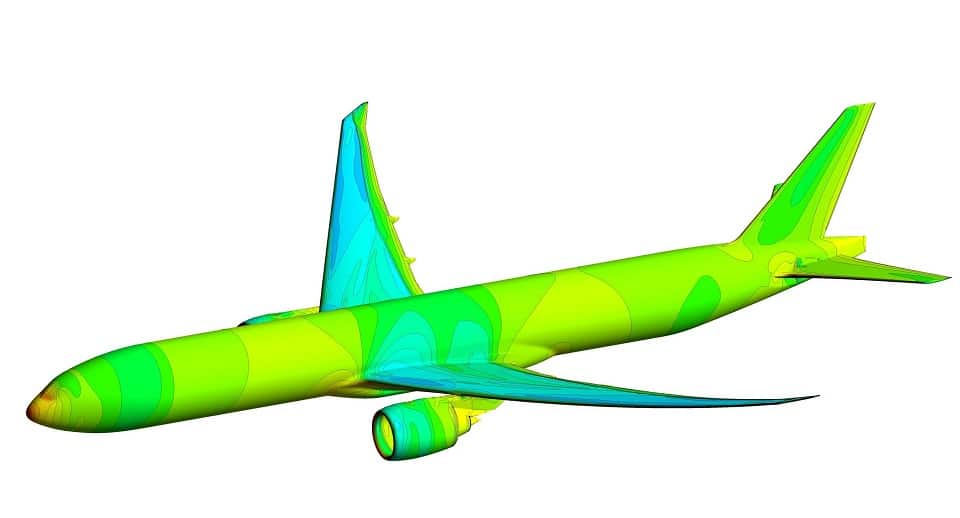Aerospace
Lufthansa Technik Uses Ansys to Develop and Certify AeroSHARK Technology

In order to design and certify AeroSHARK, a biomimetic coating technology that mimics shark skin and greatly lowers fuel consumption and carbon dioxide (CO2) emissions, Lufthansa Technik, one of the world’s top providers of technical aircraft services, integrated Ansys simulation systems.
Lufthansa Technik and BASF, a chemical business, created the coating film with a slight ribbed structure made up of tiny elevations known as riblets by utilizing Ansys’ computational fluid dynamics (CFD) and high-performance computing (HPC) technologies.
Lufthansa with aerodynamic sharkskin film(Opens in a new browser tab)
The placoid scales on a shark’s skin, which let them smoothly cut through water by lowering drag and friction while improving buoyancy, are mimicked by the riblet effect. To be sure the riblets’ surrounding turbulent flow phenomena would provide the same effect, engineers employed Ansys’ CFD software.
Before scaling and customizing the AeroSHARK prototypes through extensive aerodynamic simulations, Lufthansa Technik built and validated smaller, more generic virtual prototypes using Ansys’ capabilities. Lufthansa Technik significantly shortened the time it took to obtain certification by being able to simulate the entire aircraft, including in-flight behavior, and verify the Riblet effect using cutting-edge turbulence modeling.
Lufthansa Technik to maintain India’s Vistara Dreamliners in Frankfurt(Opens in a new browser tab)
Swiss International Air Lines (SWISS) and Lufthansa Cargo are now using AeroSHARK, which has been approved for use on two models of Boeing 777s by the European Aviation Safety Agency (EASA) and the American Federal Aviation Authority (FAA). After receiving their AeroSHARK modifications, all eleven Boeing 777Fs at Lufthansa Cargo and all twelve 777-300ERs at SWISS will cut the yearly carbon footprint of the Lufthansa Group by more than 25,000 tonnes.
As a result of successful simulation-powered testing, AeroSHARK is currently able to cover 40% of the aircraft, with plans to eventually expand its coverage to other parts of the aircraft.

Aerospace
Boeing Transfers Rocket Stage to NASA, Paving Way for Human Moon Mission

Boeing has achieved a significant milestone by providing NASA with the second core stage of the Space Launch System (SLS) rocket.
This crucial component, crafted at NASA’s Michoud Assembly Facility (MAF), is set to propel the Artemis II crew into lunar orbit, marking humanity’s return to deep space after a 50-year hiatus.
The monumental Boeing-built rocket stage, the largest element of the Artemis II mission, will embark on a journey aboard the Pegasus barge, traveling 900 miles to NASA’s Kennedy Space Center.
Comparison of two legendary aircraft B777x vs B747 aircraft:Click here
Upon arrival, it will be meticulously integrated with other essential Artemis II components, including the upper stage, solid rocket boosters, and NASA’s Orion spacecraft within the iconic Vehicle Assembly Building. This intricate integration process is a vital step toward the eagerly anticipated Artemis II launch, slated for 2025.
“Boeing-built products helped land humankind on the moon in 1969, and we’re proud to continue that legacy through the Artemis generation,” remarked Dave Dutcher, vice president and program manager for Boeing’s SLS program. “Together, with NASA and our industry partners and suppliers, we are building the world’s most capable rocket and paving the way to deep space through America’s rocket factory in New Orleans.”
NASA, Lockheed Martin Reveal X-59 Quiet Supersonic Aircraft:Click here
The delivery of Core Stage 2 marks a significant achievement in the evolution of the SLS rocket. Towering over 200 feet and powered by four RS-25 engines, this core stage, coupled with two solid-fueled booster rockets, will generate a staggering 8.8 million pounds of thrust. This immense power is crucial to launching Artemis II and future missions into the vast expanse of space.
The SLS rocket stands unparalleled in its capability to transport both crew and substantial cargo to the moon and beyond in a single launch. Its extraordinary capacity will facilitate the delivery of human-rated spacecraft, habitats, and scientific missions to destinations including the moon and Mars, ushering in a new era of space exploration.
-

 Travel1 week ago
Travel1 week agoAir India to Expand US Operations with Three New Routes After a Decade
-

 Travel2 weeks ago
Travel2 weeks agoWhy We Should Avoid These Stamps in a Passport
-

 Airlines1 month ago
Airlines1 month agoInvestigations Reveal Fake Chinese Titanium in Boeing and Airbus Jets
-

 Tech4 weeks ago
Tech4 weeks agoChina’s CATL Plans 1,800-Mile Electric Plane Launch by 2027
-

 Airport3 days ago
Airport3 days agoTop 10 Largest Airports in the World by Size
-

 Aerospace4 weeks ago
Aerospace4 weeks agoChina’s Fighter Jets Turn Wings into Autonomous Drones
-

 Airlines4 days ago
Airlines4 days agoAir India Rolls Out A350s for Delhi-New York JFK and Newark Routes
-

 Defence3 weeks ago
Defence3 weeks agoBoeing Enhances Chinook with New Engines and Block II Upgrades at $96 Million







